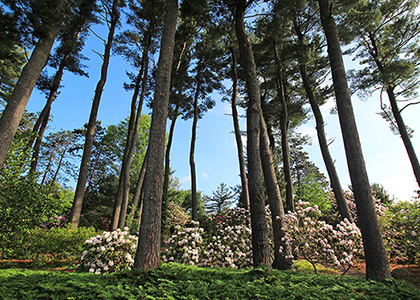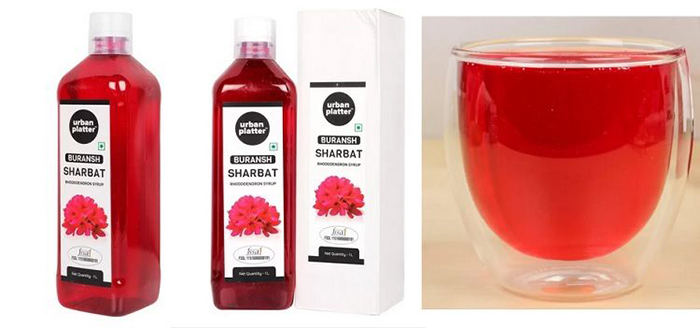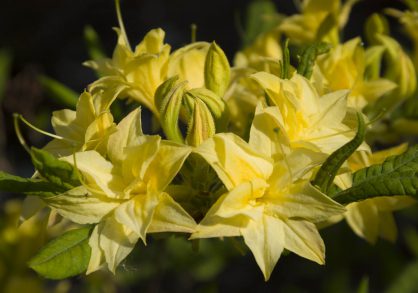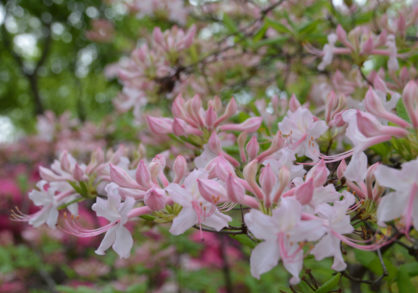
From mid-May to mid-June, a main attraction at Cornell Botanic Gardens is the Bowers Rhododendron Collection. More than 100 different varieties of plants in the Rhododendron genus cover a small hill behind the Nevin Welcome Center, with brilliant blooms of white, pink, purple, yellow, and even red. Rhododendrons, which include Azaleas, are extensively used as ornamental plants around the world—cherished for their evergreen leaves and large, beautiful, rose-like flowers (Rhododendron means “the tree of roses” in the Greek language).
While we most often associate Rhododendrons as the plant of choice for home landscapes, this group of plants has long been used as food, medicine, and wood material around the world.
Rhododendron is one of the largest genera of flowering plants with more than 1,000 wild species, most of which occur in the Himalayan region and Southeast Asia. A much smaller number of species grows in North America, Europe, parts of the Middle East, and northeast Australia.
Cultural Uses
The red flowered Rhododendron arboreum is the national flower of Nepal, where it is called lali gurans. During bloom time, women wear flowers in their hair, and the blooms are given as offerings at Buddhist temples.
Also in Nepal, fresh flower petals of R. arboreum are used to flavor a sweet drink, eaten with salt and chilies, and added to fish curries in the belief that they dissolve any fish bones which might get caught in the throat.
R. arboreum is the state tree of the northern India region of Uttarackhand. There it is used to make a sweetened drink called “buransh squash”, which is sold commercially.

Also native to the Himalaya region, R. anthopogon’s fragrant leaves are used as an incense in Buddhist temples. The essential oil distilled from the leaves is said to be calming.
The fine-grained wood of many rhododendron species is used for making bowls, spoons, furniture and fences. It is also used for firewood, which produces a long-lasting heat, and for making charcoal.
Traditional Medicine
The leaves, stems, and flowers of Rhododendrons have been documented as having toxic side effects if consumed in large doses. Despite their toxicity, Rhododendrons have been used as traditional medicine for a wide variety of treatments, and rhododendron remedies may have promise in addressing inflammatory and autoimmune diseases.
- Rhododendron dauricum and R. molle are listed in the Chinese Pharmacopoeia to treat cough, migraine, swelling, and pain associated with injuries from falls.
- In Korea, R. brachycarpum was used in folk medicine for the treatment of diabetes, arthritis, headache, and hypertension.
- Traditional Tibetan herbalists used flowers and leaves of R. anthopogon and R. anthopogonoides to treat inflammation, lung and skin disorders, and general body weakness.
- In Nepal, flowers of R. anthopogon and R. campanulatum are used for the treatment of different types of pain, while R. lepidotum is used to purify the blood and also mixed with other plants to combat common cold symptoms.
- In the Himalayan region of India, R. arboreum flowers are used in a wine to curb altitude sickness and also used for the treatment of dysentery, dyspepsia, diarrhea, nose bleeding, and removal of fish bones stuck in the gullet.
- In Europe, leaves of R. ferrugineum have been used in Germany for the treatment of rheumatism, hypertension, muscle pain and metabolic disease.
- R. luteum and R. ponticum have been used in Turkish traditional medicine against inflammation, rheumatic pain, and externally for fungal infections.
- In North America, Cherokees have been using R. calendulaceum to treat rheumatic and women’s ailments and R. maximum as analgesic and anti-rheumatic.
- In the northern territory of Canada, R. tomentosum and R. groenlandicum are used to prevent diabetes by the Inuit and Cree nations.
Rhododendrons at Cornell Botanic Gardens
Most of the rhododendrons people cultivate are hybrids, which come from cross-pollinating one species with a different species or hybrid. Today, there are tens of thousands of hybrid rhododendrons. More than 130 hybrids are displayed at Cornell Botanic Gardens, almost exclusively in the Bowers Rhododendron Collection. Among these are some older varieties that are proving themselves hardy and beautiful over decades. Expert horticulturist Phil Syphrit shares his experience with these “ironclad” Rhododendrons in this short article.
Whether you are able to enjoy these spring beauties at Cornell Botanic Gardens or around your home, we offer this sampling of rhododendrons to delight in their impressive variety and their connection to cultures around the world.
Explore Rhododendrons and Azaleas
Click the button below to explore a sampling of more than 130 rhododendrons and azaleas grown at Cornell Botanic Gardens.


